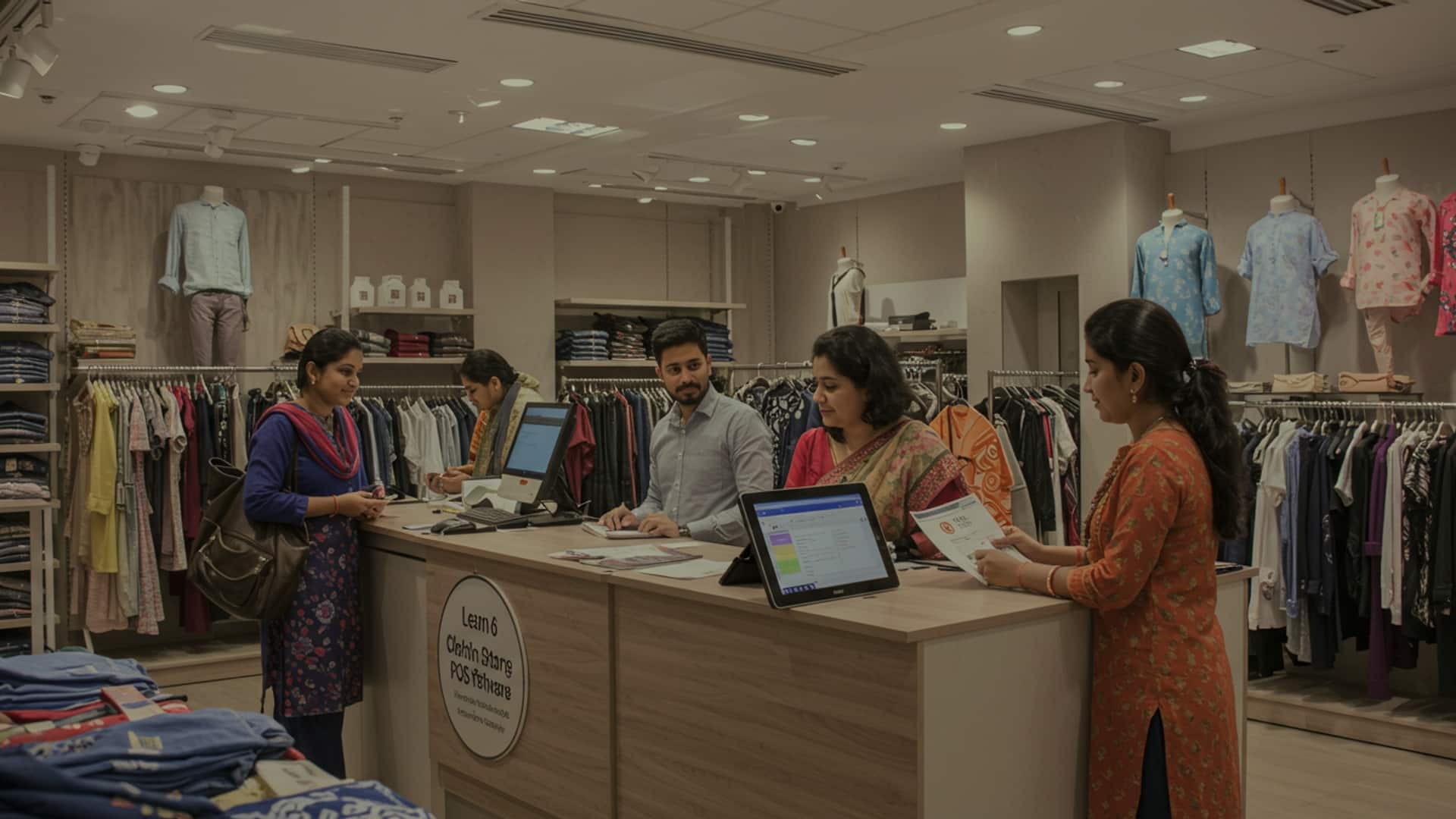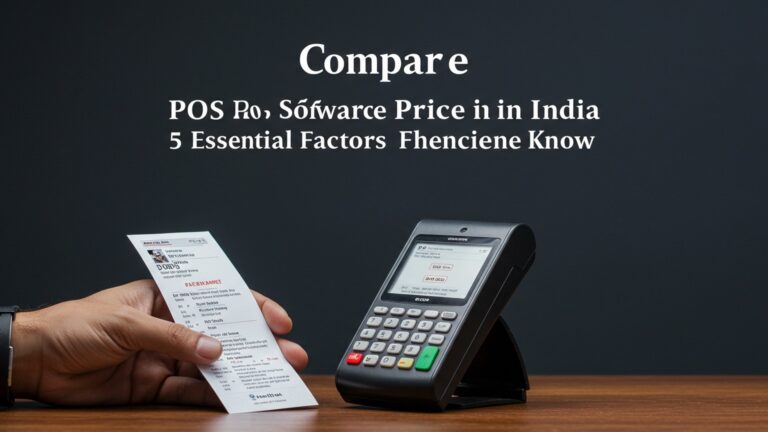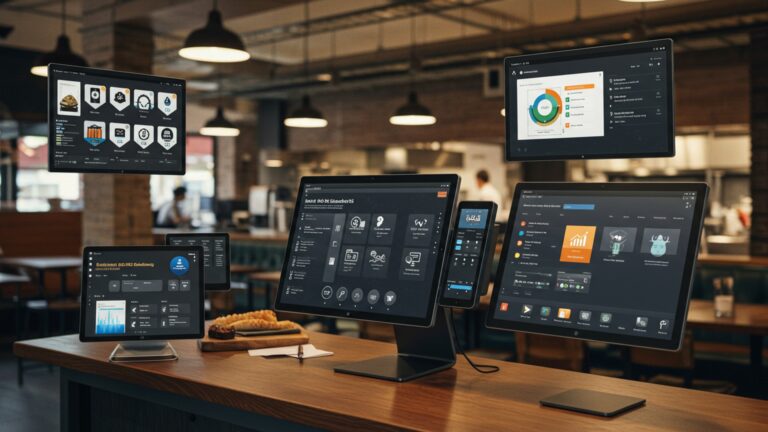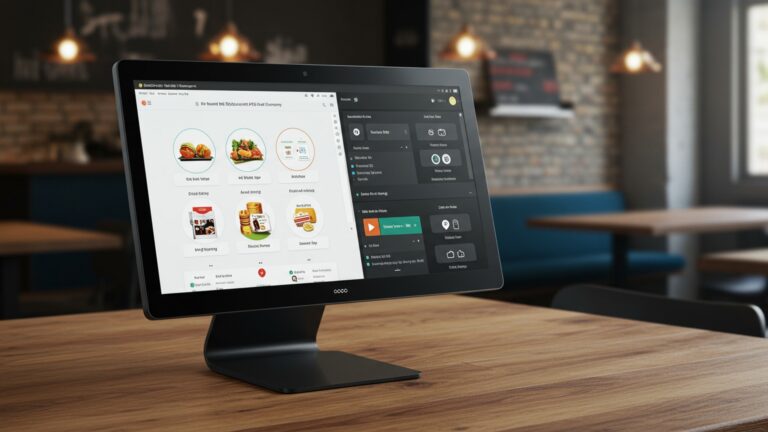Learn 6 Smart Clothing Store POS Software Strategies for India
The dynamic Indian fashion retail landscape demands more than just basic billing; modern apparel businesses thrive on strategic technology. Savvy retailers are leveraging advanced clothing store POS software India solutions to navigate market complexities, from managing diverse seasonal collections to processing high-volume UPI transactions. These intelligent systems transform the point-of-sale from a mere transaction tool into a powerful engine for omnichannel integration, providing real-time inventory visibility across physical stores and e-commerce platforms. They enable precise customer segmentation for hyper-personalized promotions, optimize stock levels to reduce dead inventory. ensure seamless GST compliance. Embracing such sophisticated POS technology is no longer optional but essential for enhancing operational efficiency and delivering superior customer experiences in India’s competitive retail environment.

1. Mastering Inventory Management with Your POS System
For any clothing store, effective inventory management is the bedrock of profitability. The sheer variety of items – different sizes, colors, styles. seasonal collections – makes manual tracking nearly impossible and prone to errors. This is where a robust clothing store POS software India truly shines. It transforms a chaotic backroom into an organized, data-driven operation.
What is Inventory Management in POS?
At its core, POS inventory management involves tracking every single item from the moment it enters your store until it’s sold. This includes:
- Stock Levels
Knowing exactly how many units of each SKU (Stock Keeping Unit) you have. For a clothing store, an SKU might look like
T-SHIRT-M-BLUE-SS24
(T-shirt, Medium, Blue, Spring/Summer 2024 collection).
Generating and managing orders with suppliers based on sales data and anticipated demand.
- Returns and Exchanges
- Inter-store Transfers
Seamlessly processing customer returns and updating stock levels instantly.
For multi-outlet businesses, moving stock efficiently between locations.
Handling different sizes, colors. styles under a single product entry.
India’s diverse fashion landscape, coupled with frequent festive seasons and rapidly changing trends, demands agile inventory control. Imagine a scenario where a popular kurta set is selling out fast at one branch, while another branch has excess stock. Without a centralized POS, you risk losing sales at one end and accumulating dead stock at the other. A smart clothing store POS software India ensures you can quickly identify these discrepancies and take action.
- Automate Reordering
- Utilize Barcoding
- Track Best-Sellers & Slow-Movers
- Conduct Regular Audits
Set minimum stock thresholds. When an item falls below this, your POS can automatically generate a reorder alert or even a draft purchase order.
Implement barcode scanning for all products. This drastically reduces checkout time and minimizes human error in stock updates.
Use POS reports to identify which items are flying off the shelves and which are gathering dust. This informs future buying decisions and markdown strategies.
Even with automation, periodic physical inventory counts (cycle counts or full counts) are essential to reconcile any discrepancies with your POS data.
2. Elevating Customer Experience with Integrated CRM
In the competitive Indian retail market, customer loyalty is a priceless asset. A basic transaction is no longer enough; customers expect personalized experiences. An integrated Customer Relationship Management (CRM) module within your clothing store POS software India is your secret weapon to build lasting relationships.
A POS system with CRM capabilities goes beyond just recording sales. It captures and organizes customer data, including:
- Purchase History
- Contact details
- Preferences
- Loyalty Program Status
What they bought, when. how much they spent.
Name, phone, email, date of birth.
Sizes, preferred brands, styles, colors (can be manually noted or inferred from purchases).
Points accumulated, rewards redeemed.
This data then enables targeted marketing and personalized service.
Consider a customer, Priya, who frequently buys ethnic wear from your store. Her purchase history in your POS-CRM shows she prefers size M and often buys silk sarees. During the Diwali season, your POS system can help you segment your customer base and send Priya a personalized SMS or email about new arrivals in silk sarees in her size, perhaps with an exclusive discount code. This level of personalization, powered by smart clothing store POS software India, makes customers feel valued and encourages repeat business.
- Build a Loyalty Program
- Capture Customer Data at Checkout
- Segment Customers for Targeted Marketing
- Personalized Communication
Implement a points-based or tier-based loyalty program that integrates directly with your POS. Reward repeat purchases and offer exclusive benefits.
Train staff to politely ask for customer contact details (name, phone, email) during every transaction. Explain the benefits of joining your loyalty program.
Use your POS-CRM data to create customer groups based on purchase history, demographics, or spending habits. Tailor marketing campaigns for each segment.
Send birthday wishes with special offers, notify customers about new collections relevant to their past purchases, or invite them to exclusive preview sales.
3. Seamless Omnichannel Retail with POS Integration
The lines between online and offline shopping are blurring. Indian consumers increasingly expect a consistent and seamless experience whether they are browsing your website, scrolling through social media, or visiting your physical store. Omnichannel retail isn’t just a buzzword; it’s a necessity. your clothing store POS software India is the central nervous system that makes it possible.
Omnichannel means providing a unified customer experience across all touchpoints – your brick-and-mortar store, e-commerce website, mobile app, social media. even customer service lines. It’s not just about having multiple channels (multichannel); it’s about these channels working together harmoniously.
A truly integrated POS system acts as the single source of truth for inventory, customer data. sales across all your channels. Here’s a comparison of traditional vs. integrated POS for omnichannel:
| Feature | Traditional POS (Disconnected) | Integrated POS (Omnichannel Ready) |
|---|---|---|
| Inventory Sync | Manual updates, separate stock for online/offline, stockouts. | Real-time, unified inventory across all channels, accurate stock levels. |
| Customer Data | Separate customer databases for online/offline. | Single customer profile, unified purchase history and loyalty points. |
| Order Fulfillment | Online orders managed separately, no in-store pickup option. | “Buy Online, Pick Up In Store” (BOPIS), “Ship from Store” capabilities. |
| Returns/Exchanges | Online purchases cannot be returned in-store easily. | Seamless returns/exchanges across any channel. |
With increasing internet penetration, many Indian consumers research products online before buying. A customer finds a dress she likes on your website but wants to try it on. With an integrated clothing store POS software India, she can check its availability at her nearest store online and choose to “Click & Collect. ” The POS updates the inventory in real-time, reserves the item. notifies the store. This convenience significantly enhances the customer journey and drives footfall.
- Integrate E-commerce with POS
- Offer BOPIS (Buy Online, Pick Up In Store)
- Enable “Ship from Store”
- Unified Returns Policy
Ensure your online store’s inventory, sales. customer data sync automatically with your physical store’s POS.
Provide customers with the flexibility to order online and collect from their preferred store location.
If your central warehouse is out of stock, use in-store inventory to fulfill online orders, reducing lost sales.
Allow customers to return or exchange items purchased online at your physical stores. vice-versa.
4. Leveraging Data Analytics & Reporting for Strategic Growth
Running a clothing store in India often involves gut feelings and experience. true growth comes from informed decisions. Your clothing store POS software India is not just for transactions; it’s a goldmine of data waiting to be analyzed. Unlocking its reporting capabilities can provide invaluable insights into your business performance, helping you make strategic choices.
What Kind of Data Does POS Provide?
A modern POS system collects a wealth of operational and sales data, including:
- Sales Reports
- Inventory Reports
- Customer Reports
- Employee Performance
Daily, weekly, monthly. yearly sales totals; sales by product, category, staff member. time of day.
Stock levels, slow-moving items, fast-moving items, inventory turnover rate, stock value.
Top customers, customer spending patterns, loyalty program engagement.
Sales per employee, average transaction value per employee.
The raw data is just numbers; the insights come from analysis. For example, by analyzing sales data, you might discover that your traditional wear section sees a 50% spike in sales during festive months like October-November, while casual wear peaks during summer. This insight, readily available from your clothing store POS software India, allows you to adjust inventory, staffing. marketing efforts accordingly.
Comparison: Basic vs. Advanced POS Reporting
| Feature | Basic POS Reporting | Advanced POS Reporting (AI/ML capabilities) |
|---|---|---|
| Sales Data | Total sales, sales by item/category. | Predictive sales forecasting, trend analysis, sales by weather patterns. |
| Inventory Insights | Current stock levels, reorder alerts. | Optimal reorder points, demand forecasting, markdown optimization. |
| Customer Insights | Top spenders, basic purchase history. | Customer segmentation, churn prediction, personalized product recommendations. |
| Visualizations | Simple tables and charts. | Interactive dashboards, heatmaps, customizable reports. |
- Identify Peak Sales Periods
- Optimize Product Assortment
- examine Promotional Effectiveness
- Monitor Employee Performance
- Forecast Demand
Use sales reports to comprehend when your store is busiest. Optimize staffing and stock during these times.
Regularly review best-selling and worst-selling items. Discontinue underperforming products and double down on popular ones.
Track sales during promotions to comprehend which campaigns yield the best ROI.
Use individual sales data to identify top performers and areas where staff might need additional training.
Utilize historical sales data to predict future demand for different clothing categories, aiding in smarter purchasing decisions.
5. Ensuring Seamless Payment Processing and Security
In India’s rapidly evolving digital payment landscape, offering diverse and secure payment options is non-negotiable for a clothing store. Your clothing store POS software India acts as the gateway for these transactions. its ability to handle various payment methods securely is paramount to customer satisfaction and trust.
Indian consumers use a wide array of payment methods:
- Cash
- Credit/Debit Cards
- UPI (Unified Payments Interface)
- Mobile Wallets
- Net Banking
- EMI Options
Still prevalent, especially for smaller transactions.
Visa, Mastercard, RuPay.
Bhim UPI, Google Pay, PhonePe, Paytm, etc. – incredibly popular for its ease of use.
Paytm, MobiKwik, Amazon Pay, etc.
Direct bank transfers.
For higher-value purchases, often integrated with specific banks or payment gateways.
A modern clothing store POS software India must be able to integrate seamlessly with these various payment gateways and devices, offering customers flexibility at checkout.
Beyond convenience, security is critical. Your POS system should be PCI DSS (Payment Card Industry Data Security Standard) compliant to protect customer card data. Look for features like end-to-end encryption for card transactions and secure tokenization to prevent data breaches.
Imagine a customer at your store, ready to purchase a premium lehenga. If your POS only accepts cash or a single card type. their preferred payment method (say, UPI or an EMI option) isn’t available, you risk losing a significant sale. A versatile clothing store POS software India ensures you can cater to every customer’s payment preference, making the checkout process smooth and swift.
- Integrate Multiple Payment Gateways
- Offer UPI Payments
- Ensure PCI DSS Compliance
- Provide EMI Options
- Train Staff on All Payment Methods
Partner with a POS provider that supports integration with popular Indian payment gateways and digital wallets.
Display QR codes prominently at checkout for quick UPI payments directly from your POS.
Verify that your POS system and payment processing adhere to global security standards to protect customer data.
For high-value clothing items, integrate with payment solutions that offer easy EMI conversions for customers.
Ensure your sales associates are proficient in handling all available payment options to assist customers efficiently.
6. Optimizing Employee Management and Performance Tracking
Your sales associates are the face of your clothing store. Their efficiency, motivation. performance directly impact customer satisfaction and sales. A comprehensive clothing store POS software India extends beyond just transactions to offer robust employee management features, helping you streamline operations and boost staff productivity.
- User Permissions
- Time & Attendance Tracking
- Sales Performance Tracking
- Commission Management
- Shift Scheduling
Assign different access levels to employees (e. g. , cashier, manager, administrator) to control data access and functionalities.
Clock-in/clock-out functionality to accurately record employee work hours.
Attribute sales to individual employees, allowing you to monitor their sales figures, average transaction value. items sold.
Calculate sales commissions directly based on employee performance data from the POS.
Some advanced POS systems offer tools to create and manage employee schedules efficiently.
In a retail environment characterized by varying footfall and seasonal rushes, effective staff management is vital. A POS system can help you identify your top-performing sales associates who excel during peak hours, or those who consistently achieve higher average transaction values. This data, gleaned from your clothing store POS software India, is invaluable for performance reviews, incentive programs. targeted training.
Suppose your POS reports show that Sales Associate Rahul consistently sells more high-value items compared to others. You can review his sales techniques, perhaps through observation or peer training, to grasp his approach and replicate his success across the team. Conversely, if another associate, Pooja, has a lower average transaction value, you can provide targeted coaching on upselling or cross-selling techniques, all informed by the precise data from your POS.
- Set Up Individual User Accounts
- Monitor Sales Metrics
- Implement Performance-Based Incentives
- Identify Training Needs
- Streamline Payroll
Ensure each employee has their unique login to track their activities and sales accurately.
Regularly review sales per employee, average transaction value. customer conversion rates.
Use POS data to reward top performers with bonuses or recognition, fostering a competitive yet supportive environment.
Pinpoint areas where employees might need additional training in product knowledge, sales techniques, or customer service based on their performance data.
Utilize time and attendance data from your POS to simplify payroll processing, reducing manual errors.
Conclusion
Embracing smart POS strategies is no longer optional for Indian clothing stores; it’s a critical differentiator for growth. My personal tip? Don’t just implement; integrate your POS into every facet of your operations, from managing your latest Diwali collection to tracking customer preferences for ethnic wear. Imagine streamlining returns or instantly knowing your bestsellers—it truly transforms daily chaos into structured growth, especially when you’ve invested time in choosing the right POS software for your specific needs. A recent trend I’ve observed is the power of real-time inventory insights. For instance, a small boutique in Delhi leveraged its POS data to identify a sudden surge in demand for specific fabrics, allowing them to reorder promptly and prevent stockouts during peak wedding season. This proactive approach, coupled with seamless UPI-enabled transactions, elevates the entire customer journey. Ultimately, a well-chosen POS isn’t just software; it’s your strategic partner, empowering you to make data-driven decisions and build lasting customer loyalty. Take the leap, optimize your systems. watch your clothing business flourish in India’s dynamic retail landscape.
More Articles
Master Apparel Store Billing 6 Features Your Software Must Have
Learn 6 Smart Strategies for Better Inventory Management with POS in India
Discover How POS Billing Software Transforms Your Business Operations
5 Best POS Features Guide for Ethnic Wear Stores to Boost Sales
How to Choose the Best Billing and POS Software for Your Business
FAQs
What are these ‘smart strategies’ for clothing store POS software in India all about?
This topic focuses on leveraging your Point-of-Sale (POS) software in clever ways to boost sales, manage inventory efficiently, improve customer experience. streamline overall operations specifically for clothing businesses operating in the Indian market. It’s about getting more than just basic transaction processing from your system.
Why is having a good POS system so crucial for a clothing store in India today?
In India’s competitive retail landscape, a robust POS system is vital because it helps you accurately track diverse inventory (especially with varied sizes, colors. styles), manage customer loyalty programs, handle multiple payment methods, gain real-time sales data. ultimately make smarter business decisions to stay profitable and organized.
What kind of practical benefits can I expect from implementing these strategies?
You can look forward to significant benefits such as reduced stockouts, faster and smoother checkout processes, a clearer understanding of your best-selling items, improved customer retention through effective loyalty programs, easier management of sales and discounts. a more precise picture of your store’s financial health and performance.
My clothing store is quite small; is this relevant for me, or only for big chains?
Absolutely relevant for all sizes! Whether you run a small independent boutique or a larger chain, these strategies are designed to help. A good POS system scales with your business, providing essential tools that can make a huge difference in managing your day-to-day operations, understanding your market. planning for future growth, regardless of your current scale.
What are some key features a clothing store owner in India should really look for in POS software?
Key features to prioritize include robust inventory management (that handles variations like size, color. material), customer relationship management (CRM) capabilities, multi-store support (if needed), integrated payment processing for various Indian methods, detailed sales reporting and analytics, efficient return/exchange management. compliance with local tax regulations.
How does POS software specifically help with managing clothing inventory, especially with so many variations?
It’s incredibly helpful! A good POS tracks every single item by its unique SKU, size, color. style. It updates inventory counts in real-time with every sale or return, helps you identify slow-moving stock. can even automate reorder points, ensuring you always have popular items available and significantly reduce dead stock.
Can these strategies actually help me interpret my customers better and improve their shopping experience?
Definitely! Your POS system is a goldmine for customer data. It can capture purchase history, preferences. contact insights. This allows you to run highly targeted promotions, offer personalized discounts, manage loyalty programs effectively. ultimately provide a more tailored and engaging shopping experience that builds strong customer loyalty.




